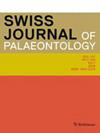New generic name for a small Triassic ray-finned fish from Perledo (Italy)
IF 2.2
2区 地球科学
Q1 PALEONTOLOGY
引用次数: 0
Abstract
Our new study of the species originally included in the genus Allolepidotus led to the taxonomic revision of the halecomorph species from the Triassic of Perledo, Italy. The morphological variation revealed by the analysis of the type material is sufficient to confirm four different taxa represented in the Perledo Formation. We correct the misunderstanding about the type species of Allolepidotus, which is A. ruppelii and not “A.” bellottii as considered in the literature over the past two decades. The latter species was originally placed in the genus Semionotus. Fossils from the Kalkschieferzone of Besnasca/Ca' del Frate (Viggiù-Varese, Italy) and Meride (Ticino, Switzerland) which were referred to Allolepidotus, rather represent a species of Eoeugnathus. Therefore, we transfer the species Semionotus bellottii to that genus and propose the new combination E. bellottii. The second and only other species originally included in the genus Allolepidotus is transferred here to the new genus Perledovatus. The holotype of P. nothosomoides new comb. has been mechanically prepared, revealing additional anatomical information that allows to place this taxon in the halecomorph family Subortichthyidae. The other halecomorph species named from the Perledo Formation, Pholidophorus oblongus and Pholidophorus curionii, have been treated as junior synonyms of E. bellottii, but our analysis indicates that they represent distinct separate taxa. However, due to the loss of the type specimens, it is not possible to decide whether they might have been conspecific with other ray-finned fishes from the Middle Triassic of the Alps.佩雷多(意大利)一种三叠纪小型鳐鱼的新属名
我们对最初被归入Allolepidotus属的物种进行了新的研究,从而对意大利佩雷多三叠纪的卤虫物种进行了分类学修订。对模式材料的分析所揭示的形态变异足以确认佩雷多地层中有四个不同的类群。我们纠正了对 Allolepidotus 模式种的误解,它是 A. ruppelii,而不是过去二十年来文献中认为的 "A." bellottii。后者最初被归入 Semionotus 属。来自 Besnasca/Ca' del Frate(意大利 Viggiù-Varese)和 Meride(瑞士提契诺州)的 Kalkschieferzone 的化石被认为是 Allolepidotus,而代表了 Eoeugnathus 的一个物种。因此,我们将 Semionotus bellottii 转到该属,并提出新的组合 E. bellottii。原属 Allolepidotus 的第二个,也是唯一的一个物种,在此转入新属 Perledovatus。P. nothosomoides new comb.的主模式是机械制备的,揭示了更多的解剖学信息,从而可以将该分类群归入半知母鱼科(Subortichthyidae)。在 Perledo Formation 发现的其他半拟态鱼类,Pholidophorus oblongus 和 Pholidophorus curionii,一直被视为 E. bellottii 的初级异名,但我们的分析表明,它们是不同的独立类群。然而,由于模式标本的丢失,我们无法确定它们是否可能与阿尔卑斯山中三叠世的其他鳐形鳍鱼类同属。
本文章由计算机程序翻译,如有差异,请以英文原文为准。
求助全文
约1分钟内获得全文
求助全文
来源期刊

Swiss Journal of Palaeontology
Earth and Planetary Sciences-Paleontology
CiteScore
4.30
自引率
16.70%
发文量
17
审稿时长
4 weeks
期刊介绍:
The Swiss Journal of Palaeontology publishes original research and review articles of interest to the international community in the fields of palaeontology, taxonomy and systematics, while recognising at the same time the importance of documenting high-quality palaeontological data in a regional context. Palaeobiology in combination with alpha taxonomy is a core topic of the journal.
Submitted papers should have an appeal as wide as possible, directed towards an international readership. Contributions should not have been simultaneously submitted elsewhere, and the overlap of content between related articles should be minimal. Duplications of text and the use of previously published illustrations without adequate citation are unacceptable. If a manuscript has two or more authors, both or all have to sign to confirm they all were involved in the work and have agreed to its submission. The preferred manuscript language is UK English, but consistently used US English is also acceptable. We encourage the publication of proceedings of international meetings as well as special thematic issues. Short contributions and book reviews are also accepted.
An international editorial team as well as guest editors guarantee that the thematic issues as well as all articles in regular issues are peer-reviewed and meet the highest standards.
 求助内容:
求助内容: 应助结果提醒方式:
应助结果提醒方式:


